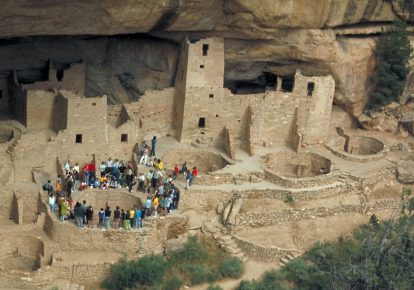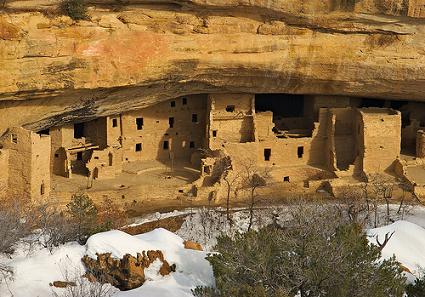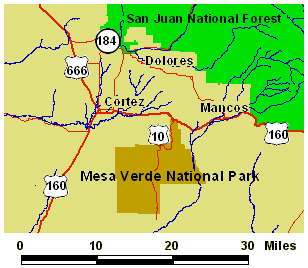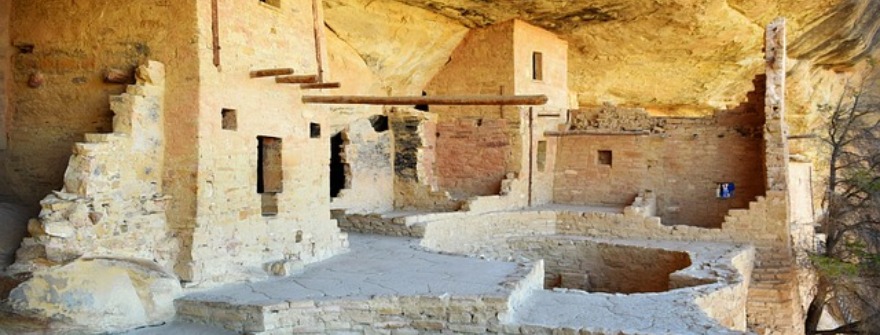Mesa Verde is the only American National Park that is devoted exclusively to archeological remains. It is set high up in the plateaus of Southwest Colorado, halfway between Cortez and Mancos. It’s an astonishing place, so far off the beaten track that its extensive Ancestral Puebloan ruins were not explored until 1888.

Mesa Verde is a densely wooded plateau, cut at its southern edge by sheer canyons that divide the land into narrow fingers. The Ancestral Puebloans are thought to have been the only inhabitants the region has ever had. No one has lived here since the thirteenth century, and no traces of human presence have been found before 500 AD. The people who built the first pit-houses here in the sixth century were already skilled potters leading a stable agricultural life.
Mesa Verde National Park offers a unique opportunity to experience an ancient cultural and physical landscape. Exhibits inside the Far View visitor center cover Navajo, Hopi and Pueblo crafts and jewelry. Immediately beyond, the road forks south to the two main clusters of remains: Chapin Mesa to the south, and Wetherill Mesa to the west. To tour any of the major ruins you must buy tickets at the visitor center.
Six miles towards Chapin Mesa from the visitor center, the Archaeological Museum holds the park’s best displays on the Ancestral Puebloans, and also sells tour tickets for the remainder of the season after the visitor center closes in late fall.
Cliff Palace
Cliff Palace, situated in the Mesa Verde National Park, in the southwest corner of Colorado, was home to nearly 150 Ancestral Puebloans people. This ancient Pueblo is the largest cliff dwelling in North America. It is a huge, magnificent ruin and was founded by Richard Wetherill and Charlie Mason in the year 1888. According to the archaeological estimates, Cliff Place was built between c. AD 1190 and c. AD 1260. However, it was vacated in 1300 for unknown reasons.

Cliff Place is constructed into an 89 ft (27 m) deep and 59 ft (18 m) high alcove in a sandstone cliff. The entire structure is nearly 288 ft (88 m) in length and has over 150 rooms. However, only 25-30 rooms have hearths, suggesting that these rooms were used as living space. Besides, there are over 75 open areas, nine storage rooms, and many other rooms whose function is not yet understood. The storage rooms were apparently reached by removable ladders and were used to store the surplus harvest.
Other main features of this large, impressive ruin include many multi-story round and square structures called ‘towers’ and 21 round sunken rooms of ceremonial importance called the “Kivas”. Abstract designs were painted on original plaster that has been used in the interior of a four-story tower at the south end of the complex. The central Kiva in the complex divides the entire structure by a series of walls with no doorways and access portals. Interestingly, the walls of this huge Kiva are plastered with one color on one side and a different color on the opposite side. This suggests that there were two communities in Cliff Palace and the Kiva was possibly used to integrate these two communities. At present, Cliff Palace is a major tourist attraction. However, it is open to the public only through ranger-guided tours.
Chaplin Mesa Archaeological Museum
The Chapin Mesa Archaeological Museum is situated on Chapin Mesa in the Mesa Verde National Park, in the U. S. state of Colorado. It is located merely 20 miles (32.1 km) from the Park entrance and nearly 5 miles (8.05 km) from the Far View Visitor Center. The Museum holds a wide range of artifacts that were discovered in and near Mesa Verde. It is through artifacts and impressive exhibits that the Museum illustrates the history of the Ancestral Pueblo People and reconstructs their daily life. The main exhibits include a chronology of Ancestral Puebloan culture, prehistoric artifacts, and several other items related to the Park.

The Chapin Mesa Archaeological Museum is also the best place to commence any tour of Mesa Verde. Besides depicting Ancestral Puebloan life, the dioramas at the Museum also offer many of the answers to the Junior Ranger activity sheets. The Museum also features a 25-minute orientation film that offers an exceptional overview of Anasazi and Park’s history. This film is shown every half hour. Also, free self-guided tours of Spruce Tree House are offered three times daily in winter, spring, summer, and fall. The Spruce Tree House cliff dwelling, situated in the Canyon below, can be reached by a short walk from the Museum. It is open to the public throughout the year and provides the explorers an opportunity to climb down into an excavated Kiva.
Other facilities offered by the Museum include a bookstore, water, restrooms, gift shop, post office, and a snack bar. The restrooms are situated near the car park. The Petroglyph Point and the Spruce Canyon Trails also start at the Museum. The Chapin Mesa Archaeological Museum is a great learning experience and is worth a visit during your stay in Colorado.
- Mailing Address: Mesa Verde National Park, PO Box 8, Mesa Verde, CO 81330-0008
- Headquarters Telephone: (970) 529-4465
- Information: (970) 529-4465
- Hours: Early Apr – early Oct, 8 AM – 6:30 PM; early Oct – early April: 8 AM – 5PM
Petroglyph Loop Trail
The Petroglyph Loop Trail is a 2.8 miles (4.5 km) trail on the Chapin Mesa in the Mesa Verde National Park in Colorado. It commences from the Spruce Tree House Trail, follows just below the edge of the southern part of the plateau, and finally makes a short climb to the rim of the Mesa. The Trail ends near the Chapin Mesa Archaeological Museum and returns via the rim. It offers breathtaking views of the spectacular Navajo and Spruce Canyons. Besides, it is the only trail in the National Park that offers visitors an opportunity to view several petroglyphs.

The Petroglyph Loop Trail has some incline but the hike is not a strenuous one. With 3 miles (4.83 km) around the loop, the trail varies in scenery and terrain beyond the points of interest including petroglyphs. This makes the trail itself quite interesting and diverse. However, before hiking the trail, it is mandatory to register at the Museum near the Spruce Tree House. The entrance gate to access this trail is open only during the visitor hours to Spruce House and the trail closes after a certain hour.
The artifacts on the trail are inimitable and extremely rare and therefore, good care should be taken to protect them. The Trail guide can be bought at the Museum for merely 50 cents. The booklet offers some interesting interpretations of the petroglyphs as well as of the plants and trees along the way. On the trail, one will also come across a stone, which the Hopi used to sharpen their knives. This stone is located very near to the Petroglyph site. The portion of the loop beyond the Petroglyph site offers an amazing view of the Canyon from the mesa top and beautiful wildflowers blooming everywhere. At the end of the trail, hikers can not only look down to Spruce Tree House but can also explore many other small ruins tucked in the folds of the cliff above.
Recreation
The park is a wonderful place for exploring, photography, hiking, viewing wildlife, camping and plant identification. Rangers in the visitor center and on the park grounds provide interpretive programs throughout each day. Check current times for these programs at the visitor center.
Climate
In summer, daytime temperatures range from 85 to 100 degrees F, dropping to 55 to 65 degrees F at night. In the winter months, the daytime temperatures may reach a high of 50 degrees F and drop to lows in the negative digits. The average precipitation is 18 inches annually.
Location
Mesa Verde National Park is located on Highway 160, 36 miles west of Durango and ten miles east of Cortez, Colorado. It lies in the southwestern corner of Colorado. The Mancos Canyon and River form the eastern rim of the Mesa. If you look at Mesa Verde on a topographical map you will see that it is riddled with canyons and creeks flowing to the Mancos River. South of the park lies the Ute Mountain Indian Reservation and Tribal Park.

Review
Mesa Verde National Park is truly one of our Nation’s hidden treasures. Visiting this Park gives one a true appreciation for the “oldest” imprint of humanity in our country. The toughest part, probably, for most people would be driving on a highway other than an Inter-state–this also happens to be the greatest reward. Escaping from bumper to bumper traffic and being able to appreciate the beauty and wildlife that you see on the way (and in Mesa Verde) makes you wonder why you weren’t brave enough to venture out of urban America before. To me, Mesa Verde National Park, Durango, Cortez, and Telluride are a forgotten part of Colorado–but once you go there you’ll never forget it and it seems to call you back.
